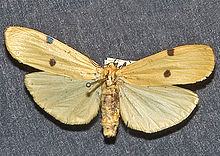Four-point lichen bear
| Four-point lichen bear | ||||||||||||
|---|---|---|---|---|---|---|---|---|---|---|---|---|

Four-point lichen bear ( Lithosia quadra ), ♀ |
||||||||||||
| Systematics | ||||||||||||
|
||||||||||||
| Scientific name | ||||||||||||
| Lithosia quadra | ||||||||||||
| ( Linnaeus , 1758) |
The four-point lichen bear or the great lichen bear ( Lithosia quadra ) is a butterfly ( moth ) from the subfamily of the bear moth (Arctiinae).
features
The moths reach a wingspan of 35 to 55 millimeters and are therefore the largest Central European lichen bears. A sexual dimorphism can be seen between the two sexes of this species . The males are yellow around the head and at the base of the wings, but most of the wings are gray. The females are completely yellow to yellow-white, but each have two blue-black points on their wings.
The caterpillars are up to 28 millimeters long. They are black-gray and have a light marbling with white narrow vertical stripes and large red spots on the back. You have long gray hair. They have a large dark spot on top of the third, seventh, and eleventh segments (at the beginning, middle, and end of the body).
Occurrence
The moths occur in southern and central Europe east to the Amur and in the south of Great Britain and Scandinavia in deciduous forests and in fruit stands, and more rarely in open terrain. They are common but are rare. Their populations are falling sharply. They fly from July to September.
Flight time
The species flies in one generation from late June / early July to late August. It is currently still unclear whether a partial second generation appears or whether the butterflies found later are latecomers of the first generation.
Way of life
The moths are nocturnal and like to come to light. During the day they can be found resting on trunks.
nutrition
They eat yellow lichen ( Xanthoria parietina ) and other lichens that grow on fruit and other deciduous trees. But you can also find them on conifers .
Reproduction
The light turquoise eggs are placed on the underside of leaves in packages of 20 to 50 pieces. The caterpillars live in small communities and initially only feed on lichens, preferably on deciduous and coniferous trees. Later they also eat leaves. After they have reached a size of around four to five millimeters, they overwinter under the bark, where pupation also takes place in a loose web next year.
swell
Individual evidence
- ↑ Günter Ebert (Ed.): The Butterflies of Baden-Württemberg Volume 5, Moths III (Sesiidae, Arctiidae, Noctuidae). Ulmer Verlag Stuttgart 1997. ISBN 3-800-13481-0
literature
- Heiko Bellmann : The new Kosmos butterfly guide. Butterflies, caterpillars and forage plants. Franckh-Kosmos, Stuttgart 2003, ISBN 3-440-09330-1 .
- Hans-Josef Weidemann, Jochen Köhler: Moths. Weirdos and hawkers. Naturbuch-Verlag, Augsburg 1996, ISBN 3-89440-128-1 .
- Manfred Koch : We determine butterflies. Volume 2: Bears, Spinners, Swarmers and Drills in Germany. 2nd, expanded edition. Neumann, Radebeul / Berlin 1964, DNB 452481929 .
Web links
- www.lepiforum.de: Taxonomy and photos
- Moths and Butterflies of Europe and North Africa (English)
- Ian Kimber: Guide to the moths of Great Britain and Ireland (English)
- www.habitas.org.uk (English)
- Lithosia quadra at Fauna Europaea

